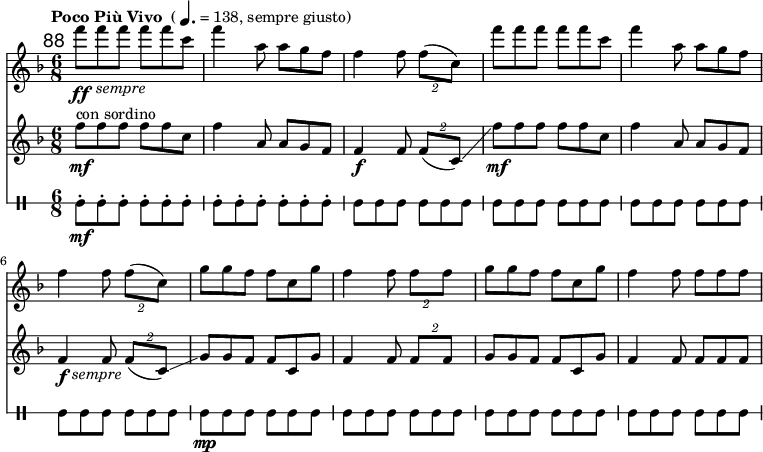印第安交響曲
外观
《印第安交響曲》(Sinfonía india)是墨西哥作曲家卡洛斯·查維斯的交響作品,屬於他第二首交響曲,於1935-36年間創作,被譽為是查維斯的代表作。本作品採用單樂章結構寫成,但仍可分為三個小「樂章」,各小樂章均配以一首傳統墨西哥北部的印第安人旋律所發展出來。
創作背景
[编辑]作品於1935年12月起開始創作,這時查維斯正藉在美國作首次的公演,翌年年初即於紐約完成,隨即便於1月23日在一個電台演奏會中由哥倫比亞廣播公司交響樂團作首次演出,同時4月10日由波士頓交響樂團作音樂會首演。至於墨西哥國內首演則於同年7月31日舉行[1]。由於音樂具有原住民色彩,亦反映了作曲家對自己民族的身份認同,很快便在美洲地區普及起來,及後更為其他地方所認識。
配器
[编辑]本曲採用浪漫主義音樂時期的規模,其中敲擊樂器採用了大量印第安「亞基部落」(Yanqi)所使用的樂器。當席爾默公司出版樂譜時,把這些亞基樂器改以接近西洋樂團中類近的敲擊樂器代替,並在樂器頁中描述相關的樂器對應。
- 木管樂器:2短笛(其中第2短笛兼任第3長笛、2長笛、3雙簧管、E♭調高音單簧管、2B♭調單簧管、B♭調低音單簧管、3巴松管
- 銅管樂器:4圓號、2小號、2長號
- 敲擊樂器:定音鼓、印第安鼓、沙槌、金屬搖鈴、吊鈸、中鼓、紙板搖鈴、擊木、木琴、小鼓、木搖鈴、刮瓜、大鼓、㓤棒
- 斜體文字為替代樂器
1971年席爾默公司出版了由弗蘭克·威廉·埃里克森改編的管樂團版本樂譜,這個改編雖然未有得到查維斯的正式認可,然而他也曾指揮過這版本,亦作出了一些修正[2]。
全曲演奏時間約為 12-13 分鐘。
樂曲分析
[编辑]- 引子(第1式)(單簧管、低音單簧管、巴松管、中提琴、大提琴)

- 引子(第2式)(小號)

- 引子(第3式)(所有木管樂器)

- 第1主題 (雙簧管、第一小提琴)

- 第2主題 (E♭ 調單簧管、B♭調單簧管、中鼓)

- 第3主題 (圓號、長笛、弱音小號及長號)

- 終段 (E♭調單簧管、弱音小號、刮瓜)

外部連結
[编辑]注釋
[编辑]- ^ Slonimsky, Nicolas (1945):Music of Latin America. New York: Thomas Y. Crowell Company,第234頁。
- ^ Parker, Robert L. (1983):Carlos Chávez, Mexico's Modern-Day Orpheus. Twayne's Music Series. Boston: Twayne Publishers. ISBN 0-8057-9455-7,第72頁。







